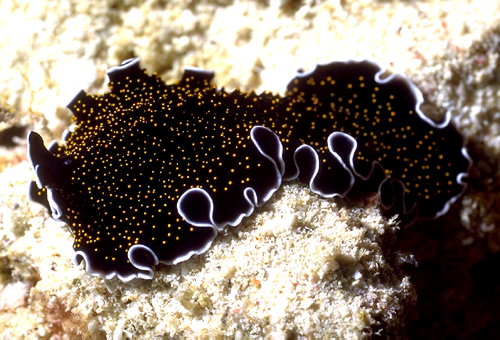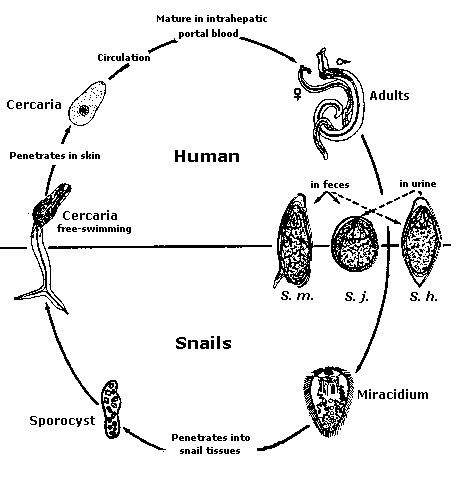

Source of images or here © Wolfgang Seifarth
Notes for Chapter 14:
Platyhelminthes (Flatworms)
Click link to return to Lecture
Schedule
or back to Chapter 13
or ahead to Chapter 15 (lab only)
or ahead to Chapter 16 (will be covered Oct. 1, 3)
Optional trip to Zzyzx
is coming up! Oct. 6-7.
Images from previous years: 1
- 2
- 3
- 4
Chapter 14 Assignment:
Ch. 14: 281-296, 300-302; RQ-14: 1-3, 8-10, 13
Introduction:


Source
of images or here
© Wolfgang Seifarth
Featured organism: The
marine polyclad flatworm,
Thysanozoon
nigropapillosum
More
Beautiful Free-living Flatworm Links: 1
- 2
- 3
- 4 - 5
- 6 - 7
- 8
Topics
planuloid hypothesis
Types of interspecific interactions:
competition/predation/symbiosis
Types of symbiosis:
commensalism/mutualism/parasitism (also a type of predation)
complex life histories:
intermediate/definitive hosts
Trematoda (flukes) and Tapeworm life cycles
Parasite adaptations
Types of interspecific interactions
mutualism (+/+): both species benefit
commensalism (+/o): one species benefits, no affect on other
competition (–/–): bad for both species
predation (+/–): predator benefits at expense of prey
Types of interspecific interactions (another approach)
true predator – few prey taken per feeding
grazer - many prey per feeding, nonfatal
parasite – few hosts in lifetime, usually nonfatal
parasitoid – larval develops inside host, fatal
Parasite Categories
1. By size
–micro (Plasmodium – malaria)
–macro (liver flukes, tapeworms)
2. By habitat
–ecto (lives on)
–endo (lives in)
Parasite Adaptations
1. Adhesive organs (attach to host)
2. Sense organs reduced
3. Modified nutrient uptake
– tapeworms have reduced digestive tract, tegument absorbs material
– food storage areas
– suckers, suck body fluid
4. Most energy goes for gametes
5. Transfer mechanisms, host to host
– complex life cycles
– motile larval stages
– resistant gametes or zygotes
6. Host recognition mechanisms - complex chemical, behavioral,
and physiological signals between host and parasite
7. Coevolution is striking
Flatworm Terms (Study!):
epithelium (ectoderm)
parenchyma (mesoderm)
acoelomate
ocelli
rhabdite
tegument
syncytial
complex life histories
hermaphroditism
intermediate/definitive hosts
Trematoda (flukes): 1 - 2 - 3
miracidium: 1 - 2 - 3 - 4 , sporocyst, rediae: 1 , cercariae: 1 , metacercariae
opisthaptor (Monogenea)
scolex (Cestoda: 1 - 2 - 3)
proglottid

source
of image of Schistosoma life cycle
Click link to return to Lecture
Schedule
or back to Chapter 13
or ahead to Chapter 15 (lab only)
or ahead to Chapter 16 (will be covered Oct. 1, 3)
This page created 9/21/01 © D.J. Eernisse, Last Modified 9/25/01, Links Last Completely Checked 9/25/01